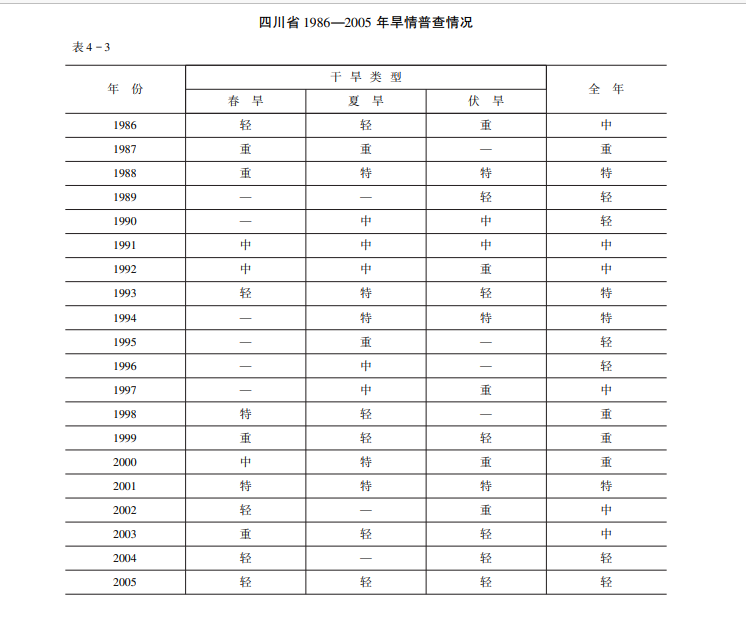What year is the worst drought year in Sichuan?How do people fight drought?
Author:Chuanguan News Time:2022.08.16
Chuanguan News reporter Zhang Tingming
The Central Meteorological Observatory continued to issue high -temperature red warning at 6 o'clock on August 16: It is expected that during the day on August 16, the highest temperature in some areas in eastern Sichuan can reach 40 ° C. As of August 15, a total of 10 cities in the province launched a municipal -level drought resistance response.
What are the droughts in Sichuan? What year is the worst drought year since the meteorological data record? How does the people of Sichuan resist drought? On August 16, a reporter from Sichuan Guan interviewed the experts of Zhishu and consulted the "Sichuan Provincial Chronicle", "Sichuan Province · Geography" and "Sichuan Province · Agricultural Chronicle", and revealed the secrets for everyone.
What are the droughts in Sichuan?
Zhishu experts told reporters that according to the records of the relevant books, Sichuan's drought is divided into: spring drought, summer drought, drought, and winter dry.
According to relevant information records, the long -term control of early and delay and a single dry gas group in the southeast monsoon is the main reason for the drought in Sichuan. Spring and summer rainfall moved from east to west. If the monsoon is weak and late, there are few rain in the west and central parts of the basin to form spring and summer arid weather. July and August Due to the high pressure control of the Pacific subtly, the eastern area of the basin is clear. Insufficient rainwater, droughts appear, sometimes drought can last until September; the basin is controlled by the dry cold airflow in the north in winter, and winter dryness often occurs.
"According to the relevant records, Sichuan droughts are roughly divided into four areas: spring dry areas, summer dry areas, Fuha dry areas, and Donggan District." Zhishu experts told reporters that the severe spring drought area (that is, regions with frequency greater than 60% ) It is mainly distributed in the area of Mianyang, Jianyang, Neijiang, and Zigong. The average drought frequency in this area is about 80%, and the highest Jianyang and Anyue can reach more than 80%. The district is mainly concentrated in Guangyuan, Mianyang, and Chengdu Plain, with a maximum frequency of drought in the area of 76%; the severe zone with the frequency of drought more than 60%is mainly distributed on the coast of the Yangtze River and the Jialing River. Essence Chengdu, Renshou, Shijiahong, and the north of Dachuan District are severe in winter, with a frequency of more than 60%. Essence

Sichuan Province 1986-2005 Drought Census Survey Source: "Sichuan Province · Water Conservancy"
What year is the most serious drought year?
"Sichuan Province · Agricultural Chronicle" records that in the 35 years from 1951 to 1985, there were 33 years of drought in varying degrees. Especially in the 1960s and 1970s, it was the most concentrated period of drought. In 1961, the summer drought was the heaviest, and it was spread across the basin. It was the most disaster in the three districts of Mianyang, Neijiang, and Leshan. It continued from early May to late June.
"According to the drought census of the relevant books, during the 20 years of 1986 to 2005, Sichuan basically had to varying degrees of drought every year." Zhishu expert told reporters, "Sichuan Province · Water Conservancy" records, 2001 In the year, Sichuan was a great drought year and was the worst drought year since the meteorological data record.
In 2001, Sichuan suffered a large area of winter dryness, spring dryness, summer drought, and drought. There were 74 counties in the basin, and spring drought occurred in 82 counties. Summer droughts occurred in 82 counties. Droughts occurred in 63 counties. Among them, 37 counties were winter dry, spring drought, summer drought, and drought drought. At that time, there was no province's large precipitation process in Sichuan's flood season, which led to a sharp decrease in rivers and rivers. There was a serious situation of rare flood season without flood season.
In 2001, the drought area was 47.2418 million acres, of which: the crop's drought area was 44.381 million mu, the disaster was 21,643,900 mu, and the harvest of 7.0629 million acres was closed. Economic losses are more than 8 billion yuan.
At that time, the worst of the drought was 5.56 million, and the lack of water and livestock reached 5.68 million heads, and 3.1 million people and 3.2 million livestock had more than 120 days of drinking water due to drought. Droughts led to a decrease in Xiaochun broadcast in the province, a decrease of 976,000 tons, a decrease of 2.8%. At that time, the summer drought occurred in the critical period of the main grain production area and the production of Dachun, which led to serious losses in production in Dachun. Due to the high temperature of the Qing Dynasty, the large area of the paddy field in the non -irrigation area is more than 80%in severe places. The area of spring corn -dried flowers in the heavy dry area accounts for about 30%, and the first summer corn is basically harvested.
How does the people of Sichuan resist drought?
Zhishu experts told reporters that long -term drought -proof and drought and drought and droughts allowed Sichuan people to obtain an experience, that is, to avoid harm and become passive. To put it simply, it is to combine the adjustment of the industrial structure with the production conditions, and enhance drought resistance from the four aspects of "adjusting, repairing, changing, and pushing".
According to the Sichuan Provincial Chronicle, "adjustment" is to adjust the industrial structure according to the principle of market demand and improvement. In Wangtiantian and the dead corners of the dry films with poor water conservancy conditions, change drought, and develop water -saving and drought -resistant economic crops according to local conditions. For example, Sichuan suffered severe summer dryness in 1993. Jiange County, Guangyuan City, sowed 140,000 acres of economic crops such as peanuts and sea peppers in a timely manner.
"Repair" is to build water conservancy and enhance drought resistance. Sichuan adopts the "five combinations" measures, namely the combination of large, medium, small, and micro (type), combined with, cited, and assumed. Water cellar) combine to solve the combination of irrigation water and solution to human drinking water. New projects are combined with the potential of renovation and excavation of existing water conservancy projects. "Change" means insisting on changing land and soil and building a high -yielding farmland. The steep sloping land with a degree of slope in the province accounts for about one -fifth of the province's dry land. The food output is low and unstable. Through reasonable planning, localities have adjusted the agricultural industry structure, changed the fields and soil, and returned farmland to forests in order to make more effective use of land resources.
"Push" is to promote practical technology and rely on scientific and technological drought. According to the laws and characteristics of drought, the crop layout and reform system are targeted, and the cultivation technology is improved. For example, the middle of the basin is a staggered area of spring, summer, and drought. The biggest disaster threatening is summer drought and drought. Therefore, the rice in the middle of the basin is selected from the cooked varieties, and the planting period is mastered in the past and mid -mate; corn is sown in late March; the red cricket should be planted as early as possible.
- END -
Video 丨 Xiangtan Maternal and Child Health Hospital: Caring for women's health, love in "menopause"

00:00JPEG Webkit-Playsinline Source: Red Net Xiangtan StationAuthor: Zhu KeEdit:...
Yingde Meteorological Observatory lifted the yellow warning of heavy rain [III level/heavier]
The Yingde Meteorological Observatory lifted a warning signal at 14:10 on June 08, 2022 at 14:10